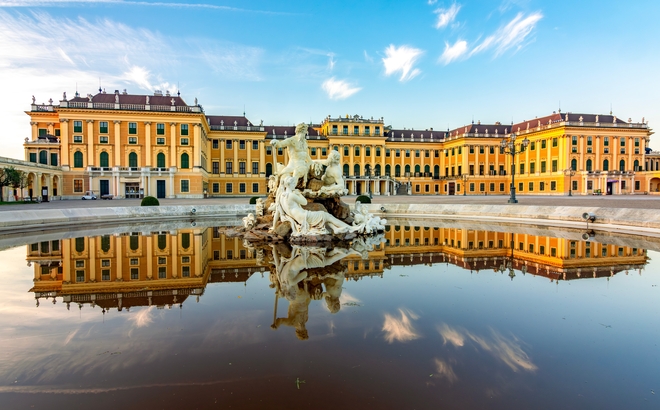The 7 Most Beautiful Cities to Visit in Europe

Europe is filled with fascinating cities where history, art, culture, and landscapes intertwine harmoniously. Looking for inspiration for your next trip? From the grandeur of Viennese palaces to the wild beauty of Icelandic landscapes, explore our selection of the 7 most beautiful cities in Europe.
Which is the Best City to Visit in Europe?
It's hard to decide as Europe is full of uniquely charming cities. Among the most beautiful cities in Europe to visit, we have selected seven: Florence, Seville, Prague, Amsterdam, Vienna, Reykjavik, and Edinburgh. Discover what makes each of these cities so special.
Florence (Italy) - The Capital of Art
The birthplace of the Renaissance, Florence is a city where art history comes to life on every corner. Its exceptional architectural heritage and breathtaking museums, including the Uffizi Gallery and the Duomo, pay tribute to Renaissance art. For nature lovers, the surrounding Tuscan countryside, with its rolling hills, vineyards, and charming medieval villages, perfectly complements the Florentine experience.
Seville (Spain) - The Soul of Andalusia
Seville captivates with its romantic atmosphere and cultural richness. Its architecture, influenced by Moorish design, boasts gems such as the Real Alcázar, a royal palace in Mudejar style, and La Giralda, a former minaret of the grand Almohad mosque. As the birthplace of flamenco and tapas, the Andalusian capital invites visitors to experience passion and conviviality, whether strolling through Plaza de España or exploring the charming Santa Cruz neighborhood.
Prague (Czech Republic) - The City of a Hundred Spires
A quintessential Central European destination and the enchanting capital of the Czech Republic, Prague is known as the "City of a Hundred Spires." This medieval treasure, with its cobbled streets and Gothic and Baroque monuments, never ceases to amaze. Crossed by the Vltava River, Prague is home to countless architectural wonders, including Prague Castle, St. Vitus Cathedral, and the iconic Charles Bridge.
Amsterdam (Netherlands) - The Venice of the North
Famous for its picturesque canals and narrow, colorful houses, Amsterdam is one of Europe's most charming cities to explore by bike, winding through its lively streets and green parks. The Dutch capital is also a cultural treasure, featuring world-renowned museums such as the Rijksmuseum, the Van Gogh Museum, and the Anne Frank House. Just outside the city, the tulip fields in bloom during spring add a vibrant and picturesque touch to this unforgettable destination.
Vienna (Austria) - The Capital of Elegance
With its imperial architecture and grand palaces, Vienna embodies the splendor of the Austro-Hungarian Empire. Highlights include Schönbrunn Palace and the Hofburg, which transport visitors into the history of the imperial family, while Belvedere Palace showcases masterpieces by Art Nouveau genius Gustav Klimt. A city of music and culture, Vienna was home to legendary composers such as Mozart and Beethoven, with iconic venues like the Vienna Opera House. Its traditional cafés, lively pedestrian streets, and royal gardens add to its timeless elegance and undeniable charm.
Reykjavik (Iceland) - Between Modernity and Wild Nature
Although small, the Icelandic capital is full of surprises, from its modern architecture to cultural landmarks such as the National Museum of Iceland and the iconic Hallgrímskirkja. Located in the heart of the Land of Fire and Ice, Reykjavik is also a perfect starting point to explore the country's natural wonders, including geysers, volcanoes, and hot springs. A fascinating contrast between modernity and raw nature.
Edinburgh (Scotland) - The Medieval Capital
Scotland's capital, Edinburgh, charms visitors with its vibrant atmosphere and breathtaking panoramas. Dominated by its majestic castle perched on an extinct volcano, the city unveils cobbled streets, mysterious alleys, and historic buildings. The Royal Mile, the city's main thoroughfare, is a must-visit, while the Old Town, a UNESCO World Heritage site, boasts impressive medieval architecture. Edinburgh is also a cultural hub, renowned for its international festival, fascinating museums, and literary atmosphere.
Practical Tips for Traveling to the Most Beautiful Cities in Europe
What Is the Best Time to Visit Europe?
Each city has its charm depending on the season. Florence is best visited in spring or autumn when the temperatures are mild and the crowds are smaller. Seville, bathed in sunshine all year round, is most enjoyable in spring and autumn, as summers can be extremely hot. Prague and Vienna take on a magical atmosphere in winter with their Christmas markets, while spring offers ideal weather for strolling. Amsterdam is stunning in April when the tulips bloom, but summer is also perfect for enjoying its canals. Reykjavik, the gateway to Iceland, is best visited in summer for endless days or in winter to witness the northern lights. Edinburgh is especially lively in August during the famous Fringe Festival, but its mysterious autumn ambiance is also enchanting.
How to Get Around the Most Beautiful Cities in Europe?
In these major European cities, walking or biking is the best way to fully immerse yourself in their atmosphere. If you want to explore more remote areas, renting a car can be a great option, especially in Iceland, where breathtaking landscapes are best discovered on a road trip.
How Long to Visit Europe?
Each of these cities deserves at least a long weekend, around three to four days, to truly capture its essence. For a more immersive experience and the opportunity to explore the surrounding regions, a week is ideal, particularly for Florence and Tuscany, Reykjavik and Icelandic nature, or Edinburgh and the Scottish Highlands.
What Visa Is Needed for a Trip to Europe?
For citizens of the European Union and the Schengen area, no visa is required to visit these European cities. A valid ID card (except for Scotland) or passport is sufficient. For non-EU travelers, a visa is required to visit Schengen countries and Scotland, depending on the country of origin. Do you need a visa? Contact the consulate of the country you wish to visit. If you don’t need a visa, don’t forget your passport and, starting November 2025, your ETIAS travel authorization for Schengen countries.
What Travel Insurance Is Needed for Europe?
Choose reliable travel insurance when applying for a visa or crossing borders with Europ Assistance’s Schengen visa insurance. Recognized and accepted by embassies and consulates worldwide, it covers medical expenses up to 60,000 euros in case of illness or accident, along with other benefits.
Tweet